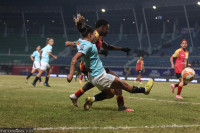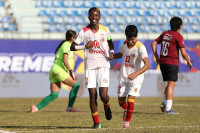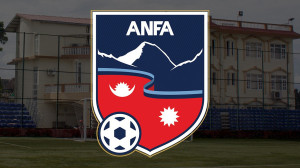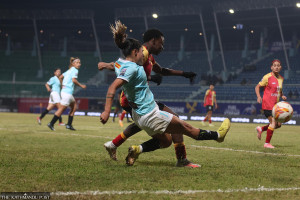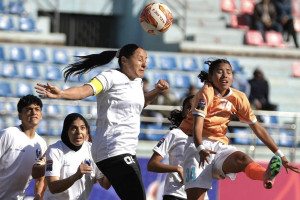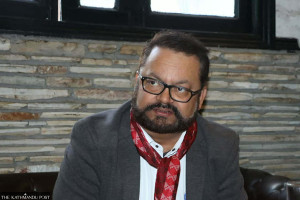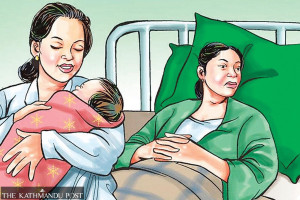Football
A Division clubs’ readiness to migrate could usher in a new era for Nepali football
That the top-tier league has been played solely in Kathmandu throughout its history has limited the number of fans and the clubs’ financial prospects.
Nayak Paudel
Nepal’s footballing scene could see a major transformation soon if the Martyr’s Memorial ‘A’ Division League is held in a home-and-away format, which seems likely after the A Division clubs agreed to migrate outside the Kathmandu Valley on Wednesday.
Ever since its first edition, in 1954, the top-tier club competition of the country has been played only in the Kathmandu Valley, mostly at the home of Nepali football—Dasharath Stadium.
Similarly, since the beginning days, the highest division has also been dominated by clubs based in the Kathmandu Valley, with only a few instances wherein clubs outside the three districts of the Valley managed a promotion to the top tier. The reason: clubs outside Kathmandu could not sustain financially at the top level.
Even now, none of the 14 A Division clubs is based outside the Kathmandu Valley—which covers 933.73 square kilometres area, approximately 0.63 percent of the 147,516 square kilometres area of the country.
There are even clubs—New Road Team, established in 1934, and Sankata FC, established in 1950—in the top-tier that are older than the A Division League and the All Nepal Football Association, which was established in 1951. However, in its seven-decade-long run, Nepal’s club football has failed to sustain itself financially.
The major reasons for the financial instability, as cited by the clubs so far, have been the lack of infrastructure—home stadiums—alongside the league’s inconsistency.
Further, the clubs have been concentrated in the Valley, limiting the number of fans, the major backbone of the clubs.
A 2025 study by EY on the Premier League’s 2023/24 season showed that the season helped generate £9.8billion in gross value added (GVA) to the UK economy—a 21 percent rise since the 2021/22 season and more than 14 times higher than in 1998/99.
It would be unfair to compare Nepal’s A Division to the world’s most-loved and watched league but the country can follow the way the global leagues operate, said Karma Tsering Sherpa, president of Himalayan Sherpa Club, at the meeting between the reigning A Division clubs and the Ministry of Youth and Sports on Wednesday.
Sherpa and a dozen of the A Division clubs’ representatives present at the meeting further said that the first step for that would be for the clubs to have their home stadiums.
The clubs were at the meeting with Minister for Youth and Sports Bablu Gupta to discuss the feasibility of organising the A Division League, which has faced a two-season hiatus. The meeting between Minister Gupta, ANFA, five A Division clubs’ representatives and Nepal Football Player Association (NFPA) on Tuesday had agreed to organise the league, which was recently postponed for one more year, within 120 days.
The postponement of the Martyr’s Memorial ‘A’ Division League by one more year, as per the agreement between ANFA and A Division clubs on November 3, was to prepare for a home-and-away format.
However, as the players did not agree to remain jobless for one more season and even staged a street protest, the newly appointed Minister for Youth and Sports Gupta took the matter seriously.
As a result, Minister Gupta, who also got the stakeholders to agree on organising the 10th National Games, after a one-year hiatus, in February 2026, has been meeting with the stakeholders. Wednesday’s meeting with the clubs was to discuss the four-month ceiling to organise the league as per the agreement reached on Tuesday with ANFA and NFPA.
‘We are ready to migrate’
The EY’s study of the Premier League suggests that the engagement between the clubs, which represent different parts and cities of England, and local fans, who have a sense of belonging to their clubs, was a major reason behind the league’s success.
“We have understood that the concentration of the clubs in the Kathmandu Valley has affected all the clubs’ revenue and fanbase, which has disallowed the social clubs from transforming into a professional one,” Sherpa, representing the A Division clubs, said in the meeting. “Thus, the clubs are more than ready and eager to play in a home-and-away format.”
And when Sherpa, who is also the former president of ANFA, added they were ready to migrate if the state helps the clubs lease the grounds and stadiums outside the Kathmandu Valley, the representatives of a dozen A Division clubs expressed their support by thumping the table.
The clubs demanded that the government help the clubs lease available grounds/stadiums outside the Valley for at least 10 years. “We will even change our clubs’ names after we migrate because we need to have the local fans take up the clubs’ badge as their own,” Sherpa said. “We will even set up academies, protect the ground, and begin the phase to become a professional club.”
The A Division clubs—except for the departmental clubs run by the three security forces of the country—are mostly social clubs operating with the financial support of the local people. “And we social clubs have not had the chance to turn professional and commercial yet,” Kapil Rana Magar, president of Satdobato Youth Club, said. “The league is not organised regularly, and we do not have our home stadiums. For social clubs like us, we cannot afford to buy a big chunk of land. So we need the state’s support to lease the available grounds for now. It will help us generate revenue and become financially stronger to pay back later.”
‘Much remains to be done’
The clubs, however, stressed that only providing grounds was not sufficient. “We target winning the A Division League to play in the club competition of the Asian Football Confederation,” said Sherpa. “But we need to have an AFC license for it, which comes with several standards.”
The AFC Club Licensing Regulations, among many rules, require a club to have a youth development programme and a stadium meeting AFC Stadium Regulations in the city where the club is based.
Until now, Nepal’s top clubs have struggled to fulfil the criteria and consistently retain their AFC club license. In 2019, the AFC slapped the ANFA a fine of USD 35,000 for violating the AFC’s regulations and incorrectly granting licenses to the clubs.
There are currently no clubs in Nepal with the AFC club license. “If we do not have the AFC license, the A Division league winner cannot play in the AFC club tournament, which is always the major goal of the participating clubs,” Sherpa said. “The state needs to help the clubs fulfil the criteria by building infrastructure that meets the minimum standards of the AFC.”
The departmental clubs also argue that the state needs to be more interested in them as they have been the pillars of Nepal’s overall sports sector, including football.
“None of the departmental clubs have yet received the match fees and winning amount from the National Women’s League since 2022,” said Jibesh Pandey, the head coach of APF’s women’s team, who represented the departmental club at Wednesday’s meeting. “Even the departmental clubs are struggling financially without the state’s support in the sports sector.”
The clubs also raised the issues regarding the difficulties to attain work permits for foreign players and the increasing trends of betting and match fixing, among others. They demanded that the ANFA form an integrity committee alongside an independent league committee to solve many of the prevailing problems.
Nonetheless, if the state, ANFA and clubs manage to take the club football scene outside the Kathmandu Valley, Nepali football will certainly see its new dawn.




 15.12°C Kathmandu
15.12°C Kathmandu



